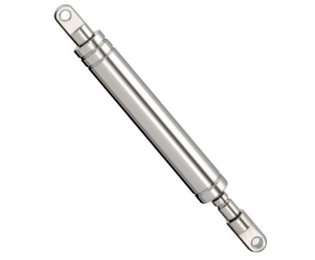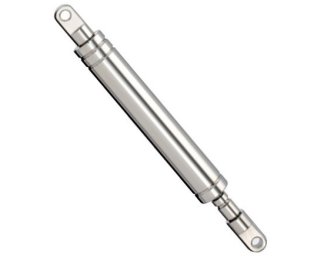Arc de tensionare cu gaz

Modul de functionare arc de tensionare cu gaz 
Tension springs work in the reverse way to compression springs, meaning that the gas pressure in the cylinder pulls the piston rod inwards.
When an opening is closed, the tension spring thus supports the manual force.
A tension spring is an enclosed, maintenance-free element. It consists of a pressure tube and a piston rod with piston. In addition, a seal to prevent possible loss of gas is fitted at the piston rod guide.
The tension spring is fitted with compressed gas – nitrogen – which provides the spring force. In the unpressurised state, the piston rod is always retracted.
Pulling out the piston rod reduces the volume in the cylinder and the gas is compressed.
This creates an increase in force (progression) for the spring, which depends on the diameter of the piston rod and the volume of the cylinder.
The piston has a small opening (nozzle), through which the gas can flow, thus allowing the piston rod to move at a defined speed.
The cross-section (diameter) of this opening defines the degree of damping of a spring.
When an opening is closed, the tension spring thus supports the manual force.
A tension spring is an enclosed, maintenance-free element. It consists of a pressure tube and a piston rod with piston. In addition, a seal to prevent possible loss of gas is fitted at the piston rod guide.
The tension spring is fitted with compressed gas – nitrogen – which provides the spring force. In the unpressurised state, the piston rod is always retracted.
Pulling out the piston rod reduces the volume in the cylinder and the gas is compressed.
This creates an increase in force (progression) for the spring, which depends on the diameter of the piston rod and the volume of the cylinder.
The piston has a small opening (nozzle), through which the gas can flow, thus allowing the piston rod to move at a defined speed.
The cross-section (diameter) of this opening defines the degree of damping of a spring.



